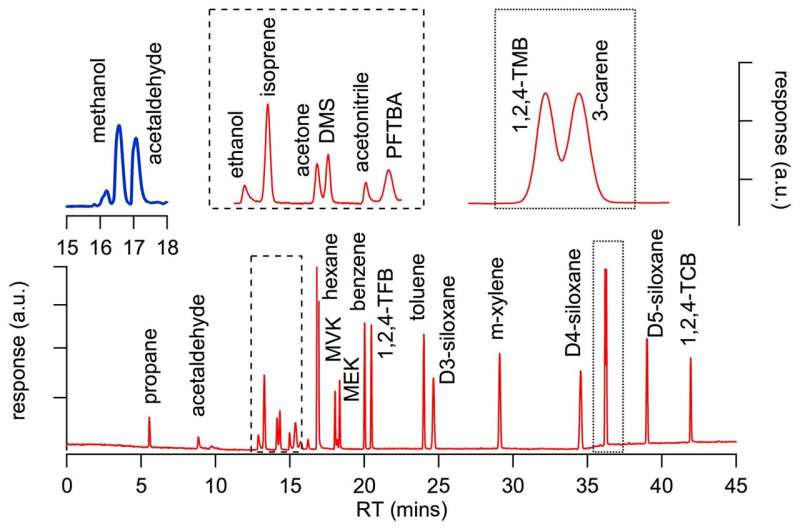This article has been reviewed according to Science X's editorial process and policies. Editors have highlighted the following attributes while ensuring the content's credibility:
fact-checked
trusted source
proofread
New calibration approach allows more widespread use of proton transfer reaction mass spectrometers

NPL and the University of Utrecht, Netherlands have collaborated to develop new SI-traceable gas reference materials and a fast calibration approach to improve the quantification and comparability of proton-transfer reaction mass spectrometry measurements. The team's research has recently been published in Atmospheric Measurement Techniques.
Proton transfer reaction mass spectrometers (PTR-MS) allow the simultaneous measurements of numerous volatile organic compounds (VOCs) in real-time at trace levels without any sample pre-treatment. As a result, it is utilized in a wide range of applications from atmospheric monitoring to disease diagnosis. The technology has matured over the last two decades and now with multiple instrument manufacturers and an explosion in datasets there is a growing need for accurate calibration and improved measurement comparability.
The large number of VOCs detectable with PTR-MS means it is impractical to have a calibration gas standard or standards for all observable compounds. However, it is possible to provide quantitative measurements for compounds without the need for specific calibration materials provided the mass dependent ion transmission rate is accurately known. This needs to be done experimentally because the transmission of PTR-MS instruments cannot be accurately predicted from theory as many use advanced ion optics to improve sensitivity that causes deviations at low masses and poor tuning and aging of the ion detection system that result in deviations at high masses.
Previous work in the field has established methods to calibrate and retrieve the mass dependent transmission. However, these are slow and labor intensive resulting in an inadequate calibration frequency limiting the application of PTR-MS to only short discrete deployments. Within the Aerosols, Clouds and Trace Gases Infrastructure (ACTRIS; www.actris.eu) project there is an interest to establish PTR-MS as a technique for long-term atmospheric monitoring. To enable this, colleagues at the University of Utrecht have developed a fast calibration approach to rapidly and accurately retrieve the mass dependent transmission when used in the conjunction with the new SI-traceable gas reference material developed by the Gas Metrology Group at NPL.
Dr. David Worton, Principal Research Scientist in the Gas Metrology Group at NPL, states, "The implementation of this new SI traceable reference material with the fast calibration method described in Holzinger et al (2019) is the most pragmatic approach to directly addressing the accuracy and comparability of PTR-MS measurements and enabling the deployment of PTR-MS for long-term atmospheric monitoring."
Professor Rupert Holzinger at the University of Utrecht, Netherlands states, "This new SI traceable Gas Standard allows exploiting the full potential of the PTR-MS technique: semi-quantitative untargeted analysis of complex mixtures across long time scales and different platforms. I expect scientific advances from this technical improvement."
More information: David R. Worton et al, Development of an International System of Units (SI)-traceable transmission curve reference material to improve the quantitation and comparability of proton-transfer-reaction mass-spectrometry measurements, Atmospheric Measurement Techniques (2023). DOI: 10.5194/amt-16-1061-2023
Provided by National Physical Laboratory




















